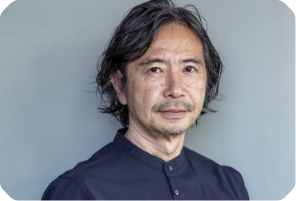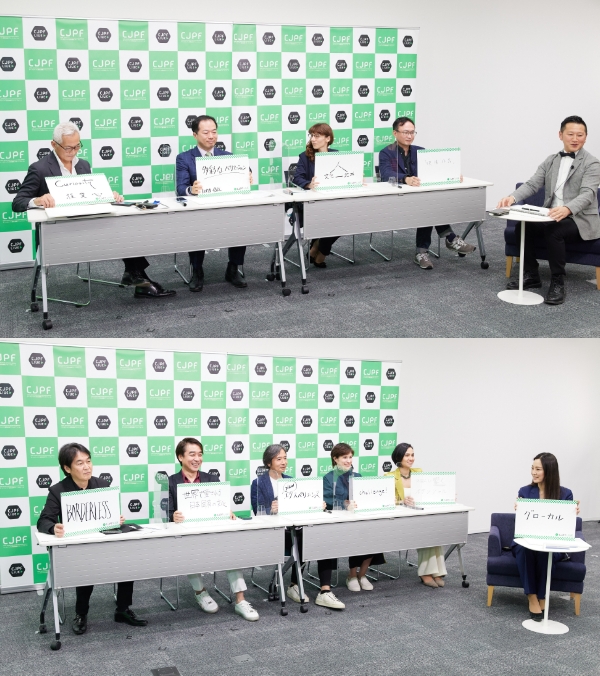Worldwide Acceptance and Recognition of Japanese Features
The CJPF Awards 2023 were set up to award Cool Japan initiatives that highlight the attractionss of Japan. The winning initiatives were selected from among 289 entries in the Movie Category and 124 entries in the Project Category. The 4th CJPF Live session was held on March 9, 2023, with judges from both categories coming together to discuss from what viewpoints they judged and assessed the entries, as well their expectations for future CJPF Awards and any areas to improve on. In addition to a strong realization of how Japanese features are accepted and recognized around the world in diverse fields, we also gained a clear picture on the future expectations and hopes for Cool Japan.
Japan and Its Regions Are Home toDiverse Attractions.The Question Is How to Communicate Them.Movie Category Part 1
In Part 1 of the session, participants discussed from what viewpoints they judged the CJPF Awards entries.
The discussions progressed based on a keyword or concept that each judge prioritized in the judging process.
Facilitating the discussion was Kenichi Watanabe, director of the Cool Japan Public-Private Partnership Platform.
Head of the judging committee was Yoshiki Tsuji, and his keyword was “curiosity.”
He says that he based his decisions on whether the entries piqued his curiosity and drove him to want to learn more as an international citizen.
Kazutaka Sato, representative of the International Otaku Expo Association and director at Circle.ms, chose “diverse variations.”
In the world of manga and anime, for example, there are many common variations.
While these are of course important, Sato says that it is the diverse variations in the genre of manga and anime that are further enhancing the appeals of the common variations.
He says, “Japan’s regions boast a diverse range of unique appeals.
I focused on entries that prominently highlighted these appeals.”
Laetitia Da Costa, meanwhile, who is product manager at Japan Experience, selected “people, cultures, and regions.”
She says that she examined whether the entry showed a complete triangle of these three elements.
That is, did it make her want to visit the region, experience its cultures, and meet its people.
Tomoe Makino is a digital strategy advisor at the Japan National Tourism Organization. His keyword was “video production.”
He says that he was intrigued by the entirely new methods that were used to create the movies, such as the cinematic techniques and video game collaborations.
“While of course unique ideas are important to ensuring that video productions stand out among many others, the method of communication is paramount.
This is where I felt the most developments had been made,” says Makino.
The movies submitted this year were of incredibly high quality, but what changes must be made to aim even higher?
Yoshiki Tsuji and Laetitia Da Costa both believe that further importance should be placed on careful storytelling and context.
Kazutaka Sato says a slightly different approach could be beneficial: “Instead of directing the videos at large global audiences of different generations and regions, creating videos that deeply resonate with specific targets could be very interesting.”

Highlighting Not Only Japan’s BeautyBut Also Its Many Other Attractions.Movie Category Part 2
In Part 2, participants discussed their future expectations for the CJPF Awards in the Movie Category, as well as areas they wished to improve on.
As the digitalization of society progresses, approximately eight billion people on earth can access to information on Japan.
In this sense, there is huge potential for the representation and communication of Cool Japan initiatives in various places.
Moving forward, how can videos be used to bring further energy to Cool Japan initiatives?
In this area, Da Costa’s key concept was “national and international co-creation.”
She says, “In an era in which social media has such a major impact on society, the role of influencers is key.
It would be great to have influencers come to Japan from abroad and create unique videos.
We could even have collaborations between Japanese directors and directors from overseas.
An increase in productions like this could be very interesting.”
For Sato, the key concept was “target-oriented planning.”
He says, “Instead of taking the main route and communicating widely to people across the world, I look forward to productions that resonate deeply with smaller targets and that develop a genuine desire to visit Japan among the viewers.”
Makino’s keyword was a straightforward “Cool Japan”.
Makino believes that in addition to Japan’s traditions and cultures, many people are interested in the Japan of today. He says, “Whether it’s anime, robots, conveyor-belt sushi, or maid cafes, it might be a good idea to show off the more modern aspects of Tokyo and other regions in Japan.
Productions that express ideas without focusing on a single format, such as anime or puppet shows, could be a true representation of Cool Japan.”
Tsuji’s concept was “humanity, humor, innovation, and learning.” He summarized by saying, “I want to communicate Japan’s many different aspects, not only its beauty.”
Finally, Watanabe chose three Es, “entertainment, encouragement, and empowerment.”
Watanabe says that videos should be fun and exciting.
He also has a strong desire to continue supporting the efforts of entrants and their projects and bring people together to give Japan a competitive advantage.
Another key part of this discussion was the frequency of comments on the importance of an international perspective.
Da Costa’s “national and international co-creation” is one such example. Meanwhile, Sato says, “As long as we think that our own project is ordinary, we won’t find the true value that it holds.
I’d love to see promotional videos on Japan that incorporate external perspectives through collaborative production, or even videos that are made by people from overseas with international perspectives.”
Makino adds, “I think it’s important to look at how to incorporate external perspectives and how to utilize them effectively.”
Tsuji has another suggestion, “We have to always be aware of the fact that the Japan that we want to communicate might not necessarily be the Japan that people from abroad want to see.
This is why it’s important to showcase many different aspects of Japan.” In this way, an international perspective could be essential to Cool Japan initiatives in the future.

Local But With a Global Perspective.Protecting Japan’s Unique Attractions.Project Category Part 1In Part 1, judges of the Project Category discussed the
In Part 1, judges of the Project Category discussed the viewpoints that they prioritized when judging the CJPF Awards entries.
The facilitator for this discussion was Sakiko Yamada, president of the Academy of Gastronomy Japan.
Takeshi Natsuno was head of the judging committee for the Project Category, and says, “There were many initiatives that made me realize that it’s no longer necessary to separate the global and Japanese markets.”
His keyword was “borderless.”
Tak Umezawa, chairman of A.T. Kearney Japan, selected “unique Japanese cultures that are loved the world over” as his key concept.
He says, “I’ve seen how it’s possible to extend ekiben, Japanese snacks, and other unique cultures that have developed in Japan to other countries just as they are.”
“New experiences” was the concept chosen by Shujiro Kusumoto, CEO of the Cafe Company.
He says, “With ekiben, anime, and particularly the Nindo Project, the lineup this year really showed how experiences can directly lead to new value and the launch of new businesses.”
Lauren Rose Kocher, representative at the Vegas PR Group, picked “challenge” as her keyword. “I thought the level of quality was much higher than in previous years.
Instead of choosing common, simple methods, many of the entries took on completely new challenges,” says Kocher.
Oya Koc is representative director and president of Oyraa.
She chose “potential to resonate with people from overseas” as her key concept, and says, “It was great to see how even those outside of Japan were creating platforms and opportunities to enjoy Japanese culture in their everyday lives.”
Finally, Sakiko Yamada selected “glocal.”
“Local but with a global perspective.
By this I mean that I want to protect Japan’s unique appeals,” says Yamada.

High-quality and Long-tailed Japanese Culture.The Increasing Importance ofCommunication Methodsand Capabilities. Project Category Part 2
In Part 2, the participants discussed their expectations for the future of the Project Category in the CJPF Awards, as well as the points where they hoped to see improvements.
Natsuno selected “ambition” as his keyword.
“There is no doubting the fact that there is a huge market focusing on Japanese culture.
I’d love to see more ambitious, surprising entries,” he says.
“Japan’s precious cultures and rich natural surroundings have high added value.
Using this added value I’d love to provide luxurious experiences across Japan, particularly in its outlying regions,” says Umezawa, who chose “luxury” as his keyword. Kusumoto, on the other hand, selected “price increases.” He says, “Recently, Japan has a reputation for its cheap, delicious food.
What I want to focus on is not the ‘cheap’ aspect, but the ‘delicious’.
This is why we have to roll out initiatives to increase value in Japan,” says Kusumoto.
Kocher chose “imagination,” and says, “Next year, I look forward to entrants further using their imagination to come up with never-before-seen, surprising initiatives.”
Koc believes that there are many countries and locations where understanding of Japan’s many appeals have yet to take root. Her key concept was to “increase Japan fans.”
She says, “I hope to see mechanisms that deliver Cool Japan initiatives to niche areas.”
Yamada, meanwhile, selected “diversification over internationalization” as her key phrase.
“I believe it is now the time that people from overseas can now accept and recognize Japanese culture as one of the world’s diverse cultures,” she says
Umezawa has used the phrase “High-quality and Long-tail aspects” to describe Japanese culture.
With many individuals, such as creators, with a craftsman-like spirit, he believes it is now the time for Japan to confidently yet carefully engage in worldwide promotion of the outstanding quality it has developed.
Effective marketing and branding will be key to doing so.
Natsuno finishes by saying, “Instead of forcefully setting lower prices, it will be important to market the history and stories.”
We are no longer in an era in which good products sell themselves.
Moving forward, it will be increasingly important to prioritize Japan’s soft aspect and examine the best ways to communicate its attractions.

登壇者プロフィール
-

【Movie Category】Yoshiki Tsuji
School Headmaster, Tsuji Culinary Institute; Chairman, Tsujicho Group
-

【Movie Category】Kazutaka Sato
Representative Director, International Otaku Expo Association Representative Director, Circle.ms
-

【Movie Category】Kenichi Watanabe
Director, Cool Japan Public-Private Partnership Platform / XPJP Inc.
-

【Movie Category】Laetitia Da Costa
Product Manager, Japan Experience
-

【Movie Category】Tomoe Makino
Chairman, Foundation for Meta Tourism Digital Strategy Advisor, Japan National Tourism Organization
-

【Project Category】Takeshi Natsuno
Specially Invited Professor and Director of Cyber Informatics Research Institute Kindai University
-

【Project Category】Takaaki Umezawa
Senior Partner at A.T. Kearney /Chairperson of CIC Japan
-

【Project Category】Shujiro Kusumoto
Representative Director and President, CAFE COMPANY Inc.
-

【Project Category】Oya Koc
CEO of Oyraa
-

【Project Category】Lauren Rose Kocher
Vegas PR Group
-

【Project Category】Sakiko Yamada
Japan Representative of International Academy of Gastronomy CEO of FOOD LOSS BANK





